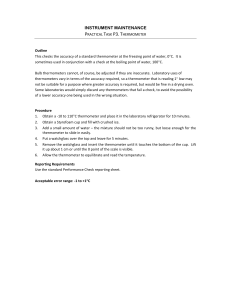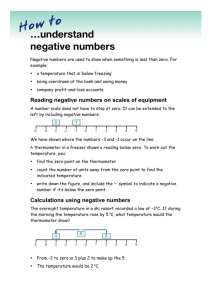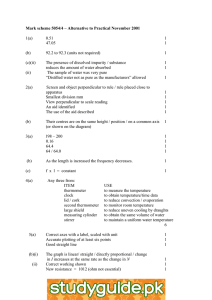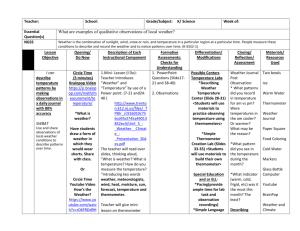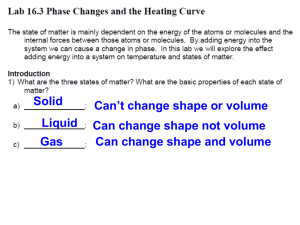WEATHER SECTION 1: WHAT IS THE TEMPERATURE? STANDARDS:
advertisement
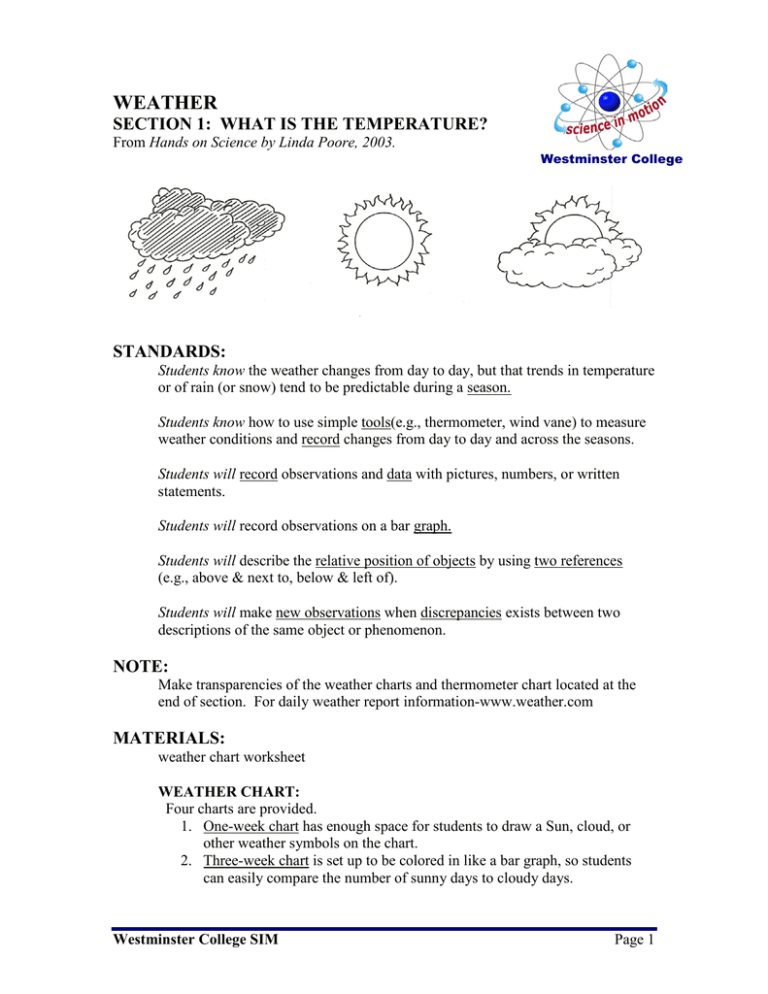
WEATHER SECTION 1: WHAT IS THE TEMPERATURE? From Hands on Science by Linda Poore, 2003. Westminster College STANDARDS: Students know the weather changes from day to day, but that trends in temperature or of rain (or snow) tend to be predictable during a season. Students know how to use simple tools(e.g., thermometer, wind vane) to measure weather conditions and record changes from day to day and across the seasons. Students will record observations and data with pictures, numbers, or written statements. Students will record observations on a bar graph. Students will describe the relative position of objects by using two references (e.g., above & next to, below & left of). Students will make new observations when discrepancies exists between two descriptions of the same object or phenomenon. NOTE: Make transparencies of the weather charts and thermometer chart located at the end of section. For daily weather report information-www.weather.com MATERIALS: weather chart worksheet WEATHER CHART: Four charts are provided. 1. One-week chart has enough space for students to draw a Sun, cloud, or other weather symbols on the chart. 2. Three-week chart is set up to be colored in like a bar graph, so students can easily compare the number of sunny days to cloudy days. Westminster College SIM Page 1 WHAT IS THE TEMPERATURE? 3. A bar graph compares the weather for 15 days. 4. The season chart records the type of weather during each season. MY WEATHER BOOK: The student work sheets together make a weather book showing what was learned. They could be numbered and placed in folders as they are completed. A WEATHER STATION: Instruments used during the unit can be grouped together for a daily weather report. (wind vane, pin wheel, anemometer, thermometer, rain gauge, etc.) MATERIALS: ice cubes(24 cubes) ice chest hot pot 3 buckets of water: room temperature, very warm, cold DEMONSTRATE: ARE YOU A GOOD THERMOMETER? HOW WELL CAN YOU TELL THE TEMPERATURE? 1. Put 3 buckets of water on a large table. Number the buckets 1, 2, 3. Do not tell students the water temperature of the buckets: Bucket 1=very warm water, Bucket 2=room temperature, Bucket 3=ice water. Have four students participate at a time. Have them each put 1 finger in cold water for 5 seconds. Then put the finger quickly in the room temperature water. How does the room temperature water feel? (warm) Now put one finger from the other hand in the very warm water for 5 seconds. Then put it quickly in the room temperature water. How does it feel? (cold) 2. Write the words, COLD, HOT, AND WARM. Place the word in front of each bucket when the students report how it feels. The middle bucket feels warm or cool, depending on whether their hand is cooler or warmer when placed in it. Let other students try the experiment. People do not make good thermometers as they decide if something is hotter or colder based on how they feel at the time. 3. Have the students put their hand on their forehead and tell the temperature of their forehead. (Warm? depends on hand temperature) Westminster College SIM Page 2 WHAT IS THE TEMPERATURE? MATH: Reading the Thermometer gives students opportunities to practice counting by 5’s and 10’s and observe patterns as the red liquid goes down for cold and up for hot. Thermometer pictures are provided on the student worksheets so students can color the thermometer stem red to match the real thermometer, providing a matching activity for students who do not count by 10’s yet. NOTE: Thermometers measure in °F to match the weather report. SAFETY: Do not give very hot or boiling water to students. The thermometers supplied for students in the kit are weather thermometers and reach only 120°F. The thermometers will break if put in boiling water. For students, safety, young students should not experiment with boiling water. One teacher’s thermometer is in the kit. It shows degrees in °C and °F and can be used with boiling water. Pure water freezes at 32°F and boils at 212°F at sea level. The normal body temperature is 98.6°F and comfortable room temperature is 72°F. Mix boiling water from the hot pot with room temperature water in each cup to get the desired safe temperature for students. This will provide more very warm water for the class. Check the water temperature with the teacher thermometer (°F/°C) to be sure students cannot get burned. (Never give students water above 120°F.) MATERIALS: For Each Pair thermometer 1 cup with 1” water student worksheet For The Teacher ice in the ice chest hot pot thermometer transparency 1 thermometer (F/C) 1 large demonstration thermometer EXPLORE: WHAT IS THE TEMPERATURE? 1. LEARNING TO READ THE THERMOMETER Use the thermometer page at the end of this section to make a transparency. Place it on an overhead projector. (or draw a thermometer on the chalkboard) Teach the students how to read the thermometer. What does it county by? (5’s and 10’s) Using a washable red marker on your thermometer transparency, color various heights to indicate the temperature and have students tell you what temperature the thermometer reads. Have students: Practice reading the ‘overhead’ thermometer by telling you what number the red line is above. For instance, “Ít is above 60. It is below 65.” Westminster College SIM Page 3 WHAT IS THE TEMPERATURE? 2. LARGE DEMONSTRATION THERMOMETER: Group the students together to see the large thermometer. What is the red liquid? How can we make it go up? (warmer) Have a student put his/her finger at the top of the red liquid and read the temperature. Use this thermometer in your weather station. 3. Give each student a thermometer and the worksheet, Color The Temperature. What is the temperature in the room? (Do not touch the thermometer when taking the room temperature.) Is it above 70°F? Is it above 75°F? (Answers may vary slightly due to inaccuracies in thermometers.) Color the room temperature on the thermometer on the work sheet. Put your thumb on the thermometer. What is your thumb’s temperature? Record the temperature. Did you thumb make the red liquid go up and down? (up, hotter) 4. Pass out the cups of water. Record the room temperature water on the work sheet. Add ice to the water. Stir for 1 minute. Record the temperature. Touch the ice cube with the thermometer. Wait 1 minute and record the temperature of ice. Ice freezes at 32°F. Go outside and record the temperature in sunlight and in shade. Check each student’s ability to accurately use the thermometer while they record temperatures. Remind students not to drop the thermometers! (It is safer to experiment with thermometers on the grass.) DISCUSS: WHAT IS THE WEATHER TODAY? 1. Have students list all the different types of weather. Write their weather words on the board. Use symbols, such as a Sun, for nonreaders or students learning English. 2. Use the 1-week or 3-week weather chart. Give each student a weather chart and make a transparency of the chart to use on an overhead projector or make a large class chart on a bulletin board. Discuss the weather for the day. Discuss what each word on the chart means. Color in a box for each weather term that describes the day. 3. RECORD TODAY’S TEMPERATURE ON THE CHART Decide the location and time you will take the temperature each day. (e.g., right after lunch) The weatherman takes the temperature in the shade. Use the large teacher demonstration thermometer at the weather station. Put a rubber band on the thermometer each day to mark the temperature. Have students Westminster College SIM Page 4 WHAT IS THE TEMPERATURE? compare the temperature the next day to see if it is hooter or colder. (higher or lower) 4. OBSERVING SEASONAL CHANGES Use the chart, The Seasons: What is the weather? (end of section) Discuss what the weather was like during the summer. Have students: Write the names of the summer months. Draw a Sun and write hot under weather on the chart. Write 80°F - 100°F under temperature (or the range for your city). (If students’ writing skills are inadequate, start this chart at the end of Fall and complete Summer at that time.) At the end of each season, review what students have learned and have them add information to their chart. NOTE: USING THERMOMETERS WITH VERY YOUNG STUDENTS: STUDENT THERMOMETERS: Students who have not learned their numbers can use the colors on the left side (red, yellow, blue) of the student thermometer to tell if the water is hot, warm, or cold. THE LARGE DEMONSTRANO THERMOMETER: Cut seven 6 cm x 5 cm rectangles form colored construction paper. Tape them in a vertical line up the left side of the thermometer. Put them in order, from the top: red, orange, yellow, green, white at the 32°F area (cold as snow), blue, purples. Now students can say, “It’s cooler than yesterday, it’s in the yellow,” and the teacher can read the temperature in numbers. Use a rubber band to mark the temperature on the large thermometer at the same time each day (e.g., 1pm). Students can see if the temperature goes up or down the next day (cooler or hotter). Student worksheets could also have marks to color red, yellow, and blue on the left side of the thermometer pictures, to indicate the temperature if they cannot read numbers yet. ASSESSMENT: UNDERSTANDING THE THERMOMETER Have the students write up or down to answer the following 2 questions. 1. What will the thermometer do if I put it in hot water? 2. What will the thermometer do if I put it in cold water? (Show the students the large thermometer and do each experiment to show the answers after taking this test.) MATH ASSESSMENT: MAKING A BAR GRAPH Use the worksheet, Graph Our Weather For One Month, at the end of this section to make a bar graph. Count the number of rainy days on the weekly charts and color in the boxes together as a directed activity. If it was rainy 6 days, count up to 6 squares, color the sixth one, and then color down. This activity works best in the rainy season! Did we have more sunny or rainy days? Westminster College SIM Page 5 WHAT IS THE TEMPERATURE? Westminster College SIM Page 6 WHAT IS THE TEMPERATURE? Westminster College SIM Page 7 WHAT IS THE TEMPERATURE? Westminster College SIM Page 8 WHAT IS THE TEMPERATURE? Westminster College SIM Page 9 WHAT IS THE TEMPERATURE? Westminster College SIM Page 10

